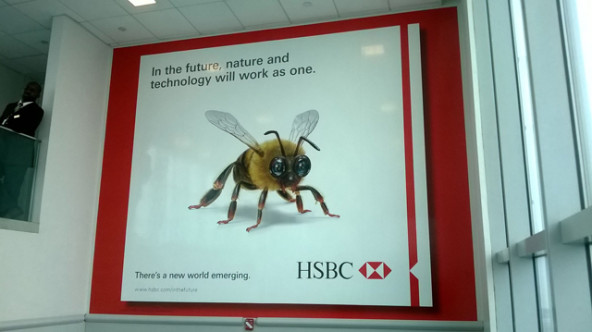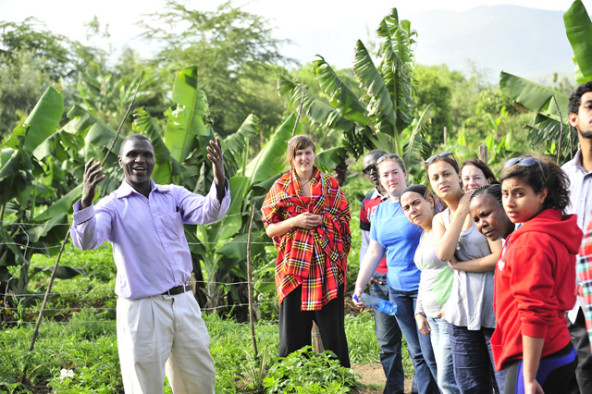While hiking with a group of our Amani Institute students in Kenya’s Crater Lake National Park earlier this year, we found ourselves at the intersection of several herds of water buffalo; they approached in a pincer movement from three different sides. If you live anywhere in Africa, you know to give these ornery creatures a wide berth, and our reactions ranged from mild anxiety to all-out terror. The only way for us to go was straight, but as we did so, it looked like one of the herds was moving to cut us off. We paused, heart rates rising.
Moments later, our guide pointed out that there weren’t three herds, but one; it was trying to come together, and we just needed to get out of the way. We walked in the direction that the buffalo cutting us off were coming from, and soon we were fine, now in the midst of a herd of much milder, though rutting, impala.
This experience exemplified how little most of us understand about nature (especially relative to our guide).
 Amani Institute students engage in learning about bio-empathy. (Photo by Amani Institute)
Amani Institute students engage in learning about bio-empathy. (Photo by Amani Institute)
For the last two years, we have been teaching a course called “Bio-Empathy: Learning from Nature” in the Lake Naivasha region of Kenya. This course opens the Amani Institute’s Certificate in Social Innovation Management program (a five-month, intensive, hands-on preparation for careers in social change), and it was born from our collective experience of not looking to nature in our professional worlds.
Are you enjoying this article? Read more like this, plus SSIR's full archive of content, when you subscribe.
Connection with nature should be easy, because it is all around us—even in the city. But there are constraints: time, money, awareness. During co-author Dharshan Wignarajah’s career, both in industry and as a strategy consultant, he worked on numerous private sector, environmental, and social challenges, but only a handful of projects looked to nature for parallels, analogies, or inspiration. Co-author Roshan Paul spent nearly 10 years working all around the world in social entrepreneurship and almost never came across a discussion about learning from nature—not even among people working in conservation. As we seek to play roles in catalyzing social change, we are struck by our limited engagement with nature and all it may teach us.
You can see how we came up with the bio-empathy course for the Amani Institute and how we approach learning from nature in this video:
In a typical life, proximity to nature and awareness of our role within it diminishes as we move through youth, education, and professional life. Our high school and college educations fail to embed and develop our need to work in harmony with all that surrounds (and holds) us. The primary goal of our course is to find ways to tap the wisdom of nature and use it to unlock innovative approaches to social problems.
We first encountered the word “bio-empathy” in Bob Johanssen’s Leaders Make the Future, where he describes it as a core competency of 21st-century leaders. But Johanssen, like us, is standing on the shoulders of giants—indigenous cultures throughout history, Leonardo da Vinci, Antoni Gaudi, John Milton, and the founder of the field of biomimicry Janine Benyus.
 HSBC commercial in a large international airport. (Photo by Roshan Paul)
HSBC commercial in a large international airport. (Photo by Roshan Paul)
In our bio-empathy work, we draw strongly from the field of biomimicry, especially its six life principles. And yet, for all its pioneering work, biomimicry still mostly exists in the realm of science; it’s primarily concerned with form and material, products, and technology. Our goal is to learn how to adapt biomimicry toward illuminating and solving social challenges.
It’s important to note that leading biomimics like Benyus are not just scientists. They are also intensely conscious of their personal relationship with nature, and through this connection—almost spiritual in its depth and awe for nature—they conceive many of their ideas for innovative solutions. Some of the more famous of these solutions include how the bullet train in Japan was designed to mimic the beak of a kingfisher, how we can save energy by designing buildings according to the way air flows inside a termite mound, or how the stripes on a zebra circulate air currents. They show us that if we are going to improve our capacity for innovation, we first need to deepen our own connection with nature.
Our bio-empathy course thus brings together two strands of thought: biomimicry, or “nature as mentor,” and “nature as mirror,” which is about reconnecting with a wisdom about nature that we’ve lost. Our students spend time re-connecting with nature through a number of immersive experiential activities, receive an introductory understanding of biomimicry theory, and then apply all they learn to a local social problem. Over the last two years, we have applied this learning to scaling organic farming, investing in sustainable floriculture, and conserving local bio-diversity, all highly emotive topics in the ecosystem of Lake Naivasha.
 Amani Institute students learning about sustainable farming from Kenyan farmer Josephat Njoroge. (Photo by Jerry Zhu)
Amani Institute students learning about sustainable farming from Kenyan farmer Josephat Njoroge. (Photo by Jerry Zhu)
The course also serves another role—a role that nature is best positioned to facilitate. It is the first activity of our management program, prior to orientation, and encourages our students (who are either taking a new direction in life by coming to Kenya, or based locally but immersed in busy careers) to step back a bit, think differently about the world around them, and envision a new way of interacting with the world—all useful preparation for their social innovation journey at the institute.
Some students remain puzzled by the fact that they never before encountered such thinking. One student said, “How is it possible that I did a bachelor’s in environmental studies in Canada and didn’t learn any of this?”
We see applications and uses for bio-empathy in both the public and private sectors (see Giles Hutchins’ The Nature of Business), but even more so in the social sector, since social ecosystems often mimic natural ecosystems (see Fritjof Capra’s The Hidden Connections). If we foster new skills, tools, and techniques to explore and unearth the latent knowledge within and around us, then we can tap into a whole new source of ideas and inspiration for people solving social problems.
At the end of the course this year, one of our students, Roseline Orwa, a cancer survivor and tireless advocate for the rights of widows in Kenya, shared a single moment that had summed up the whole course for her:
“I looked around, and there was full life around me, unspoken, just like the turmoil inside me: the fears and worries for my health, the children at my center with few or no resources, and the widow community who look up to me. I learnt that I need to carry this silent synergy with me. It is not important to have all the answers at once. Sometimes I will fall, just like the acacia trees; some days I will stand strong and bring life; some days I will be calm like the beautiful lake; and other days I may happily jump about like the monkeys and insects. All this is life, and I need to know when different moments require different skills to aspire and inspire.”
Support SSIR’s coverage of cross-sector solutions to global challenges.
Help us further the reach of innovative ideas. Donate today.
Read more stories by Roshan Paul & Dharshan Wignarajah.

